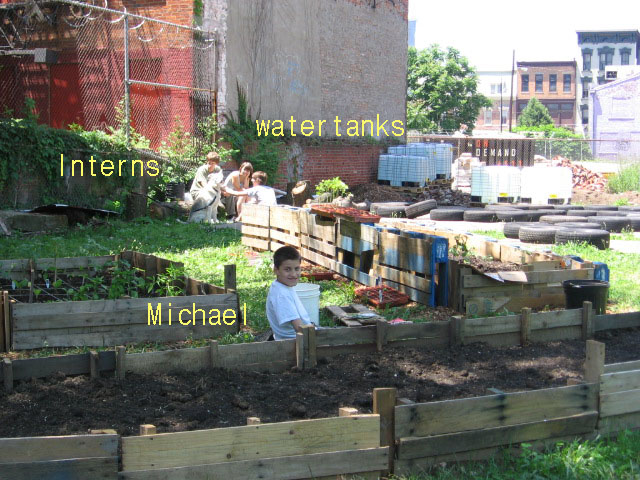No one realized how much water comes off a roof in only a short rain fall, but after the first rain we were all amazed! I marked the water line of one of our three 220 gallon tanks in an attempt to measure how much water we would collect from the rooftop reclamation system our University of Cincinnati engineering student interns designed and constructed. I figured that we might increase that tank by a few inches, maybe even a foot. In the morning after a pretty good rain I was dumbfounded to find that all three 220 gallon water tanks were full to the brim! Success! When you do not have water pumped into a garden location the alternatives are few, pretty much water has to be shipped in. Or, Sarah Seheb has to fill up a wheel barrel at her place and wheel it four blocks through city traffic 25 times to water the garden by hand. Not feasible.

Storing water from rooftops- What we learned
When we thought about it became clear that it doesn’t take much rain when you have 90 square feet of collecting rooftop space funneling into one tank. Just one 220 gallon tank could water the entire quarter acre garden three to four times; so it is a real blessing to have one of these tanks completely full. And get full they did. One thing that we learned is to ensure that the overflow outlet is piped back into the sewer drain to ensure adequate drainage. The foundations of a building are put at risk when water drains at their base.
Water Reclamation to Slow Runoff and Sewer Overflow
In Cincinnati, Ohio, like most cities in the United States, we have a sewer system that when it rains more than the sewers can handle there is a back flow of “natural pollution” released into tributaries of the Ohio River like our Mill Creek. Recently I was informed by the Mill Creek preservation organization that “natural pollution” from sewers overflowing is the number one pollutant of our Mill Creek. Our city, in a valiant attempt to catch the flood of water that runs into the sewers during heavy periods of rain has built a huge underground tributary under I-75 at exit 6 in St. Bernard. The theory is that we can hold enough run off until a large amount of the water is processed and then empty the underground holding area when our sewers have the capacity. Theoretically, if 25 percent of citizens collected run off in a large tank from their own roof during rains, then empty the tank when the sewers can handle the capacity, we could possibly avoid the dangerous toxic pollution that we have now extolling from our own sewer system during heavy rains..
Thanks to the Coca-Cola Company for donating the 220 gallon water tanks.
